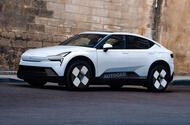The Polestar 7 is gearing up to make waves in the electric vehicle market, and it’s not just another model in the lineup. This upcoming crossover is being positioned as the brand’s first mass-market offering, and it’s expected to significantly boost sales for the Swedish automaker. But what does this mean for Polestar’s identity and its commitment to performance? Let’s dive into what we know so far.
What Makes the Polestar 7 Different?
At its core, the Polestar 7 aims to retain the premium feel and dynamic driving experience that fans of the brand have come to expect. CEO Michael Lohscheller has emphasized that while the 7 will be more accessible to a broader audience, it will still embody the “Polestar DNA.” This means that regardless of whether it’s built on a new platform or one borrowed from the Geely group, the driving experience will be distinctly Polestar.
Lohscheller pointed out that the differences between the Polestar 3 and the Volvo EX90 serve as a great example of how two vehicles can share a platform yet feel entirely different. The Polestar 3 is designed for performance, while the EX90 leans more towards comfort and safety. This differentiation is crucial for Polestar, and it’s clear that the 7 will follow suit, offering a sporty character that aligns with the brand’s ethos.
How Will the Design Evolve?
Design is a significant focus for the Polestar 7, with Lohscheller stating that the new model will showcase an evolved design language aimed at instilling more confidence and emphasizing performance. The brand’s new head of design, Philipp Römers, is leading this charge, aiming to make the cars “less minimalistic” while still retaining the recognizable Scandinavian aesthetic.
While the specifics of the design changes are still under wraps, Lohscheller hinted at a more compelling look that will resonate with the performance-oriented nature of the vehicle. It’s an exciting prospect for fans who appreciate the brand’s unique style but are eager for a bit more flair.
Where Will the Polestar 7 Be Built?
Production of the Polestar 7 is set to take place in Europe, although the exact location is yet to be confirmed. The Ghent factory in Belgium is a strong contender, especially with Volvo’s new plant in Slovakia also coming online soon. This strategic decision not only aligns with Polestar’s commitment to sustainability but also ensures that the vehicle can be produced closer to its primary market.
What Can We Expect in Terms of Performance?
While specifics about the powertrain and performance metrics haven’t been disclosed, Lohscheller’s comments suggest that the Polestar 7 will be engineered to deliver an exhilarating driving experience. The brand has built its reputation on performance, and this new model aims to uphold that legacy. Expect a vehicle that not only looks the part but drives with the kind of responsiveness and agility that Polestar enthusiasts crave.
The Big Picture: What Does This Mean for Polestar?
The Polestar 7 represents a pivotal moment for the brand. By expanding its lineup with a model aimed at the mass market, Polestar is not just chasing volume; it’s also reinforcing its commitment to performance and premium quality. The challenge will be to balance accessibility with the brand’s core values, ensuring that new customers get a taste of what makes Polestar special.
The big takeaway? The Polestar 7 isn’t about perfection—it’s about smarter adjustments. Start with one change this week, and you’ll likely spot the difference by month’s end. Keep an eye on this model; it could very well redefine what we expect from electric SUVs.

